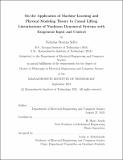On the Application of Machine Learning and Physical Modeling Theory to Causal Lifting Linearizations of Nonlinear Dynamical Systems with Exogenous Input and Control
Author(s)
Selby, Nicholas Stearns
DownloadThesis PDF (5.574Mb)
Advisor
Asada, H. Harry
Terms of use
Metadata
Show full item recordAbstract
Methods for constructing causal linear models from nonlinear dynamical systems through lifting linearization underpinned by Koopman operator and physical system modeling theory are presented. Outputs of a nonlinear control system, called observables, may be functions of state and input, Φ(x,u). These input-dependent observables cannot be used for lifting the system, because the state equations in the augmented space contain the time derivatives of input, hence anti-causal. Furthermore, finding effective observable functions for approximation with a low-order linear system remains an open question. Here, we present three methods for solving the causality problem in lifting linearization and one algorithm to further lift the new set of of causal observables using neural networks. The first method to solve the anticausal problem assumes that the observables are linearly dependent on exogenous input, then constructs a filter to remove that dependence. The second method is to replace anticausal observables by their integral variables Φ*, and lift the dynamics with Φ*, so that the time derivative of Φ* does not include the time derivative of input. The third method is to alter the original physical model by adding a small inertial or capacitive element so that the system's causal relationship changes. These augmented dynamics alter the signal path from the input to the anticausal observable, so that the observables are not dependent on inputs. The three anticausal solutions and the learned lifting linearization are applied to practical systems and numerical simulations validate the effectiveness of the methods.
Date issued
2021-09Department
Massachusetts Institute of Technology. Department of Electrical Engineering and Computer SciencePublisher
Massachusetts Institute of Technology